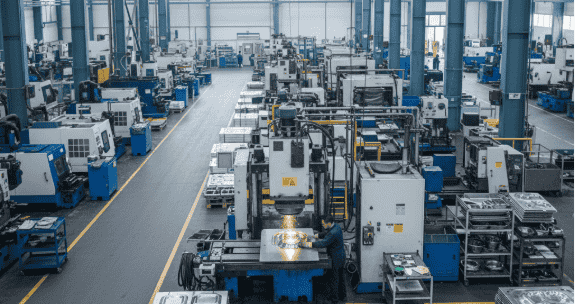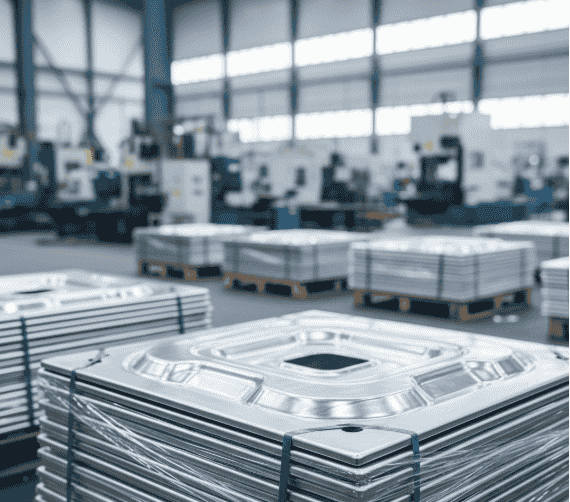Stamping stainless steel parts: process, costs and how to make the right choice
The stamping of stainless steel parts (304, 430, 316) has become one of the most demanded processes in modern industry. Thanks to this technique,
What are 304, 430 and 316 stainless steels?

Stainless steels are iron alloys with a minimum of 10.5% chromium, which gives them excellent corrosion resistance. Types 304, 430 and 316 are the most common in steel stamping, each with specific properties that make them suitable for different applications. Their main function is to offer durability, resistance to aggressive environments and a long-lasting aesthetic finish.
From the manufacture of cookware to marine components to medical equipment, the right choice of stainless steel type is crucial to the longevity and performance of the final product. Its precise and robust fabrication, such as that offered by the metal stamping process, is of vital importance.
Materials most commonly used in the manufacture of parts by stainless steel stamping
The choice of stainless steel type is one of the most important factors in the manufacture of stamped parts, as it directly affects strength, durability and cost.
- Stainless Steel 304 provides excellent resistance to oxidation and corrosion in moderate environments. It is highly valued in the food industry, for household appliances and architectural structures.
- 430 stainless steel is more economical with good indoor corrosion resistance. It is suitable for appliances, decoration and parts where cost is a determining factor and exposure to corrosive agents is limited.
- Stainless Steel 316 offers the highest corrosion resistance, especially against chlorides and saline or acidic environments. It is indispensable in the marine, medical, pharmaceutical and chemical industries.
The choice between 304, 430 or 316 depends on the final application: while a 304 stainless steel part may be perfect for industrial furniture, a 316 part is irreplaceable in equipment exposed to seawater or aggressive chemicals.
Need help?
Contact our technical office and tell us about your project.
We will study your case and propose a solution to manufacture them.
Types of processes for stamping stainless steel parts
In modern industry, stainless steel stamping processes have diversified to optimize production and ensure high quality parts.
On the other hand, hot stamping is used when higher deformation capacity is required. It is the ideal choice for thick parts or complex geometries that would be difficult to cold form due to the hardness of stainless steel.
Both methods, supported by the design of specific dies, make it possible to manufacture parts with the desired shape and properties, optimizing production times and reducing material waste.
Step by step process: how we stamp high quality parts in stainless steel
The process of stamping stainless steel parts follows a rigorous sequence to ensure precision and durability. It begins with material selection, where the type of stainless steel (304, 430 or 316) and the appropriate thickness are defined according to the application. This is followed by sheet metal preparation, which may include lubrication treatments to facilitate deformation and protect the dies.
This is followed by the design and construction of dies, tools made of wear-resistant materials that determine the exact geometry of each part. In the
Finally, the parts go through finishing and quality control phases, where surface treatments such as polishing, passivation or pickling are applied and verified to comply with international standards such as ISO. This method ensures high production volumes with uniform, corrosion-resistant parts ready for demanding industrial applications.
Advantages of stamping stainless steel parts
Stamping stainless steel parts provides clear benefits over other manufacturing methods. These include
Another advantage is the aesthetic quality finish, which makes it easier to obtain polished or brushed surfaces, highly valued in sectors where appearance is key. In addition, the cold process generates a
Surface finishing, quality control and maintenance in stainless steel stamping.
A good finish not only improves aesthetics, but also optimizes the corrosion resistance of stainless steel parts.
- Polished Mirror/Satin is widely used in decoration and home furnishings to enhance the appearance of the appearance of the stamping of sheet metal. .
- Passivation is a chemical treatment that restores the protective layer of steel, increasing its resistance to corrosion.
- Pickling removes impurities and surface oxides after forming, improving chemical resistance.
Parts stamped in stainless steel must comply with ISO regulations and strict geometric accuracy standards. A reliable supplier guarantees certifications and continuous quality controls, as well as proper die maintenance to avoid problems such as burrs, cracks or marks, which are frequent if the stamping process is not rigorously controlled.
Costs, lead times and what to consider when contracting a stainless steel stamping service
Contracting a stainless steel stamping service involves evaluating several factors beyond the price per part to ensure the best value for money.
- Factors Affecting Cost: The type of stainless steel (304, 430, 316), the thickness and complexity of the part, the volume of production, and the surface finishes required.
- Production Volume: For prototypes or short runs, the cost per piece of stainless steel is higher due to tooling preparation. However, large runs significantly reduce the unit price by amortizing the die.
- Supplier selection: It is crucial to choose a supplier with proven experience in steel stamping, modern machinery, quality certifications (ISO) and that offers additional design services and technical advice to optimize the project.

Use cases and current trends in stainless steel stamping
The stamping of stainless steel parts finds applications in various industrial sectors:
- Stainless Steel 304 is used in sinks, industrial kitchens, urban furniture and food industry components.
- 430 Stainless Steel is ideal for appliance housings, trim, interior trim and decorative parts.
- 316 stainless steel is used in medical implants, surgical instruments, industrial valves, piping for the chemical and pharmaceutical industry, and parts exposed to the sea.
These examples demonstrate how each type of stainless steel is suited to a specific industry based on its properties of corrosion resistance, durability and finish in metal stamping.
Innovation in the stamping of stainless steel metal parts
Innovation in stainless steel stamping has occurred in two main areas: raw materials and the most advanced machinery.
- Raw Materials: Progress has been made in the development of stainless steel grades with improved forming properties, maintaining their corrosion resistance and allowing more complex designs in sheet metal stamping.
- Machinery and Dies: The evolution of high-capacity presses and process control systems, together with the development of more durable and precise dies, has made it possible to manufacture stainless steel parts with increasingly complex geometries, reducing costs and production times without compromising quality in the stamping process.
Get in touch with us
Contact our technical office and tell us what kind of steel parts you need to manufacture.
We will study your case and propose a customized, fast and efficient cold stamping solution.
Frequently Asked Questions about stamping of stainless steel parts (FAQs)
Which stainless steel is best for food-grade parts?
Stainless steel 304 is widely used, but 316 is the most recommended and superior in environments with high corrosion or contact with acids present in foodstuffs.
Is it possible to stamp thick stainless steel sheet?
Yes, it is possible, but it usually requires hot stamping processes and presses of higher capacity and tonnage due to the hardness of the material.
How does the finish influence the final cost of a stainless steel part?
Surface finishes such as mirror polishing, satin polishing or passivation increase the cost of the part, but also improve its aesthetics, durability and corrosion resistance.
What is the service life of stainless steel stamping dies?
With proper design and rigorous preventive maintenance, dies can last hundreds of thousands or even millions of cycles, although stainless steel can accelerate wear due to its hardness.
Why should I choose Lemec for stamping stainless steel parts?
At Lemec we are specialists in the stamping of stainless steel parts, offering an efficient stamping process, maximum precision and rigorous compliance with international standards. With years of experience in metal stamping, Lemec guarantees quality, cost savings and personalized technical support, making it the ideal partner for companies seeking to optimize their stainless steel components.